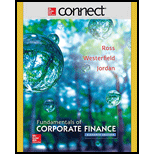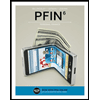
Connect 1 Semester Access Card for Fundamentals of Corporate Finance
11th Edition
ISBN: 9781259289392
Author: Stephen A. Ross Franco Modigliani Professor of Financial Economics Professor, Randolph W Westerfield Robert R. Dockson Deans Chair in Bus. Admin., Bradford D Jordan Professor
Publisher: McGraw-Hill Education
expand_more
expand_more
format_list_bulleted
Question
Chapter 23, Problem 10QP
a)
Summary Introduction
To determine: The actuarially fair insurance premium.
Introduction:
In financial perspective, the insurance is a protection from the financial losses. It is one of the popular instruments which prevent potential loss of an individual or a company with minimal cost. Generally, it is imperative to protect the companies from uncertainty or abnormal events.
b)
Summary Introduction
To determine: The maximum payment after modification.
Expert Solution & Answer
Want to see the full answer?
Check out a sample textbook solution
Students have asked these similar questions
Use clear values and give sol
King’s Park, Trinidad is owned and operated by a private company, Windy Sports Ltd. You work as the Facilities Manager of the Park and the CEO of the company has asked you to evaluate whether Windy should embark on the expansion of the facility given there are plans by the Government to host next cricket championship. The project seeks to increase the number of seats by building four new box seating areas for VIPs and an additional 5,000 seats for the general public. Each box seating area is expected to generate $400,000 in incremental annual revenue, while each of the new seats for the general public will generate $2,500 in incremental annual revenue. The incremental expenses associated with the new boxes and seating will amount to 60 percent of the revenues. These expenses include hiring additional personnel to handle concessions, ushering, and security. The new construction will cost $15 million and will be fully depreciated (to a value of zero dollars) on a straight-line basis over…
A brief introduction and overview of the company"s (a) uk vodaphone -300word history and current position in respective marketplace.A graphical illustration, together with a short written summary, of the five year trends in sales, profits,costs and dividends paid-100word
Chapter 23 Solutions
Connect 1 Semester Access Card for Fundamentals of Corporate Finance
Ch. 23.1 - Prob. 23.1ACQCh. 23.1 - Prob. 23.1BCQCh. 23.2 - Prob. 23.2ACQCh. 23.2 - Prob. 23.2BCQCh. 23.3 - What is a forward contract? Describe the payoff...Ch. 23.3 - Prob. 23.3BCQCh. 23.4 - Prob. 23.4ACQCh. 23.4 - Prob. 23.4BCQCh. 23.5 - Prob. 23.5ACQCh. 23.5 - Prob. 23.5BCQ
Ch. 23.5 - Prob. 23.5CCQCh. 23.6 - What is a futures option?Ch. 23.6 - Prob. 23.6CCQCh. 23 - Keith is preparing a graph that compares the value...Ch. 23 - Prob. 23.3CTFCh. 23 - Prob. 23.6CTFCh. 23 - Prob. 1CRCTCh. 23 - Prob. 2CRCTCh. 23 - Prob. 3CRCTCh. 23 - Prob. 4CRCTCh. 23 - Prob. 5CRCTCh. 23 - Prob. 6CRCTCh. 23 - Options [LO4] Explain why a put option on a bond...Ch. 23 - Prob. 8CRCTCh. 23 - Prob. 9CRCTCh. 23 - Prob. 10CRCTCh. 23 - Prob. 11CRCTCh. 23 - Hedging Exchange Rate Risk [LO2] If a U.S. company...Ch. 23 - Hedging Strategies [LO1] For the following...Ch. 23 - Prob. 14CRCTCh. 23 - Prob. 15CRCTCh. 23 - Prob. 16CRCTCh. 23 - Prob. 1QPCh. 23 - Prob. 2QPCh. 23 - Futures Options Quotes [LO4] Refer to Table 23.2...Ch. 23 - Prob. 4QPCh. 23 - Futures Options Quotes [LO4] Refer to Table 23.2...Ch. 23 - Prob. 6QPCh. 23 - Prob. 7QPCh. 23 - Interest Rate Swaps [LO3] ABC Company and XYZ...Ch. 23 - Prob. 9QPCh. 23 - Prob. 10QPCh. 23 - Prob. 1MCh. 23 - Prob. 2MCh. 23 - Prob. 3MCh. 23 - Prob. 4MCh. 23 - Prob. 5MCh. 23 - Are there any possible risks Joi faces in using...
Knowledge Booster
Similar questions
- A brief introduction and overview of the company"s (a) uk vodaphone (b) uk Hsbc bank, (c)uk coca-cola history and current position in respective marketplace.arrow_forwardKing’s Park, Trinidad is owned and operated by a private company,Windy Sports Ltd. You work as the Facilities Manager of the Park andthe CEO of the company has asked you to evaluate whether Windy shouldembark on the expansion of the facility given there are plans by theGovernment to host next cricket championship.The project seeks to increase the number of seats by building fournew box seating areas for VIPs and an additional 5,000 seats for thegeneral public. Each box seating area is expected to generate $400,000in incremental annual revenue, while each of the new seats for thegeneral public will generate $2,500 in incremental annual revenue.The incremental expenses associated with the new boxes and seatingwill amount to 60 percent of the revenues. These expenses includehiring additional personnel to handle concessions, ushering, andsecurity. The new construction will cost $15 million and will be fullydepreciated (to a value of zero dollars) on a straight-line basis overthe 5-year…arrow_forwardYou are called in as a financial analyst to appraise the bonds of Ollie’s Walking Stick Stores. The $5,000 par value bonds have a quoted annual interest rate of 8 percent, which is paid semiannually. The yield to maturity on the bonds is 12 percent annual interest. There are 12 years to maturity. a. Compute the price of the bonds based on semiannual analysis. b. With 8 years to maturity, if yield to maturity goes down substantially to 6 percent, what will be the new price of the bonds?arrow_forward
- Lonnie is considering an investment in the Cat Food Industries. The $10,000 par value bonds have a quoted annual interest rate of 12 percent and the interest is paid semiannually. The yield to maturity on the bonds is 14 percent annual interest. There are seven years to maturity. Compute the price of the bonds based on semiannual analysis.arrow_forwardNeed solution this wuarrow_forwardneed assarrow_forward
arrow_back_ios
SEE MORE QUESTIONS
arrow_forward_ios
Recommended textbooks for you
 PFIN (with PFIN Online, 1 term (6 months) Printed...FinanceISBN:9781337117005Author:Randall Billingsley, Lawrence J. Gitman, Michael D. JoehnkPublisher:Cengage Learning
PFIN (with PFIN Online, 1 term (6 months) Printed...FinanceISBN:9781337117005Author:Randall Billingsley, Lawrence J. Gitman, Michael D. JoehnkPublisher:Cengage Learning

PFIN (with PFIN Online, 1 term (6 months) Printed...
Finance
ISBN:9781337117005
Author:Randall Billingsley, Lawrence J. Gitman, Michael D. Joehnk
Publisher:Cengage Learning